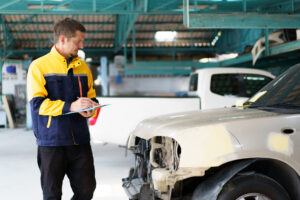
Tech, changing vehicle values driving ‘chasm’ of understanding between insurers and repairers
By onInsurance
Martin Ellingsworth, former J.D. Power P&C Insurance Intelligence managing director, spoke last week about how insurance and shop business operation trends of the past decade paired with today’s vehicle values could affect the “Garage of the Future,” and what technologies are to come that will stretch the “chasm” of repair process understanding between insurers and repairers.
During a “TechTalk360” webinar held by AirPro Diagnostics, he said shops should think about dynamic vehicle changes in the context of values and features, auto insurance, shop business strategy, and workforce management.
“In the last couple of years, the kind of crisis, pricing, the crazy world around us, car prices, and inflation has created an environment where just to survive, we’re all raising rates,” Ellingsworth said. “Everything’s been higher this last year and a half. Even if they [prices] start to go back down, they won’t go down fast enough for people that are on a limited or static income. Getting more value from the cars they have is going to be essential. The average age of cars on the street might actually creep up a bit.”
He called the jagged uptick of loss ratios and rate increases in the last few years “the line of doom” when looking at a line chart of the changes, and vehicle values not depreciating, something not seen before.
“It suddenly creates a situation where everything you thought you knew doesn’t apply anymore,” Ellingsworth said. “Everything we were going to pay now is worth something more than we thought it was going to be.”
He cited a recent report by Enlyte in which Mitchell Claims Performance Director Ryan Mandell said high used and new vehicle prices have caused the total loss threshold for insurers to rise, meaning more collision-damaged vehicles are likely to be repaired now rather than declared a total loss, according to Mandell.
“Because of that, there’s more repairs being done and there’s more parts per repair being done so it’s more complex to do the steps,” Ellingsworth said.
He noted that some newer model cars are falling below what the new prices of older models were so it may be cheaper to replace the vehicle rather than repair it.
“The industry needs to be very, very aware that they don’t know everything they don’t know,” he said. “When a safety issue for a repairer comes up or for a consumer… the process of a repair and the process of adjusting need to be modified to accept that.”
Ellingsworth predicted auto insurance will move into a phase of price accuracy and better personalization, especially with telematics-type programs.
“We are right now where we were 60 years ago,” he said. “Most of your model factors say as the car gets older, it gets cheaper on a percentage basis and it’s monotonic — it goes down every year. If you’re wrong and it doesn’t go down, it goes up [and] you’re creating an insurance to value exposure gap. Then, it just gets worse and worse as your data floats apart.”
Rather than vehicles losing value over time, they held their value or increased in value from 2021-2023, with part of the cause being the market shift from consumers favoring sedans to pickup trucks and SUVs, he added.
“If you’re using a pricing model that says cars always get cheaper, there’s only one curve for all vehicles on the market,” Ellingsworth said. “There’s no difference between a sedan versus a sports car convertible versus a pickup truck or an SUV. That inflexible structure, using what we’ve commonly learned over a 60-year period, has always been true and is now heretically but actively not true.”
For example, say a 2022 Ford F-150 Supercrew is insured for $50,000 and its actual cash value is $70,000. If there’s a total loss claim, 75% of the ACV, in this case, a $71,000 car times 75%, is about $53,000. You’d be paying the full base price, he said.
“I don’t think the rate increases have been enough yet to get to this next new level of what values are,” Ellingsworth said. “I’m also a pretty strong advocate of saying that not every car is equal when it comes to getting these types of rate increases.”
He added that a question often asked by collision repairers is how do insurers not know the actual value of a vehicle? And, shouldn’t insurers access VINs, get competitive bids, know what the car looks like, and pull the build sheets?
“Recently, both from the technology creep into the cars and the lack of understanding of how cars are built by the industry — specifically around the valuation component of if a car gets totaled in claims — there’s a dollar threshold around the actual cash value of the contract,” Ellingsworth said.
The “chasm,” as one webinar viewer put it, between the training and expertise repairers have about safe and proper repairs, including on newer technologies, versus the knowledge adjusters have is an issue that Ellingsworth said he isn’t sure we can educate our way out of.
“As the fleet becomes more dependent on driver-assisted technology, ready-for-road certification is going to be a burden on the repairer and the insurer to make sure that car is ready to be sent back to the consumer,” he said, referring to ensuring vehicles are returned to OEM safety standards.
“[From] a consumer satisfaction standpoint and an economy standpoint, I see more people holding onto ICE cars longer and harder, which means you’re going to have more repair base and staff working on old tech… There’s newer tech that you need to be ready to rumble with.”
Perhaps, he said, what’s needed are more data standards with well-understood industry-accepted terminology shared with VINs that pull the build sheet and tech features. Over-the-air (OTA) updates may or may not help with that, he added.
Based on the recent Enlyte report, Ellingsworth said since the average age of cars on the road today is seven years, he predicts shops will begin seeing more 2018-2020 model-year vehicles with standard ADAS features next year.
Shops can expect the road ahead to include more vehicles having multiple ADAS features versus a single feature with sensors that will get more and more complicated, and possibly proprietary, according to Ellingsworth.
“You’re not going to be able to just test drive a car,” he said. “You’re going to have to scan it and understand it. It’s going to be configured to the specifics of how that car was built and what version of software it’s on… Calibration is getting harder and harder to understand what the requirements are as well as to understand when it’s done.”
Images
Featured image: Stock photo of a technician evaluating damages on a vehicle. (Credit: golfcphoto/iStock)
Photo of Martin Ellingsworth (Zoom screenshot)

